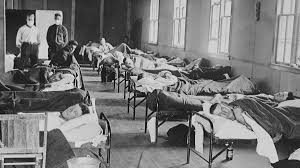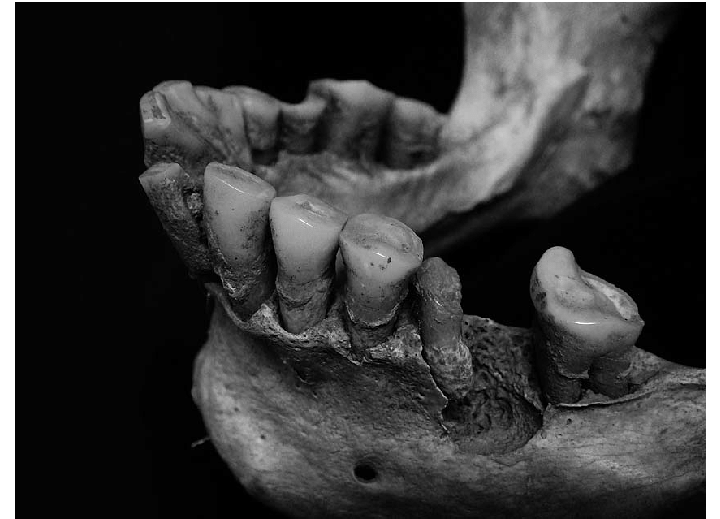#CLST6 For this #CYO2 #ArchSci I listened to an Arch&Anth Podcast interview with PhD candidate Amanda Wissler. Amanda is a bioarchaeologist; Her dissertation research specifically focuses on paleopathological analysis of skeletal remains from the 1918 Spanish Flu pandemic.
Amanda works with the Hamann-Todd osteological collection at the Cleveland Museum of Natural History. This enormous collection of skeletal remains (we& #39;re talking over 3,000 individuals!) is the world& #39;s largest documented collection of modern human skeletal remains.
The focus of Amanda& #39;s research lies in two simply defined terms: resilience & frailty. I.e. She& #39;s interested in identifying who was more likely to live (the resilient) and who was more likely to die (the frail) during the 1918 Spanish Flu outbreak.
Amanda investigated several different types of pathological legions throughout the collection in order to determine frailty. These indicators included linear enamel hypoplasia, femoral length, periodontal (gum) disease, periostosis, & the diameter of the vertebral-neural canal.
Many stress-induced indicators like cribra orbitalia & porotic hyperostosis (commonly thought to be caused by anemia) result in the bone becoming more porous/spongy in appearance. Hopefully no one in this class suffers from trypophobia! If so, I apologize for the photos  https://abs.twimg.com/emoji/v2/... draggable="false" alt="😬" title="Grimasse schneidendes Gesicht" aria-label="Emoji: Grimasse schneidendes Gesicht">
https://abs.twimg.com/emoji/v2/... draggable="false" alt="😬" title="Grimasse schneidendes Gesicht" aria-label="Emoji: Grimasse schneidendes Gesicht">
The most intriguing part of the interview covered what bioarchaeologists call the Osteological Paradox. Essentially this paradox (if one were to over simplify it) posits that the markings on skeletal remains aren& #39;t always a reliable way to discern frailty vs. resilience.
Because human bone takes several months to several years to form lesions in response to disease/illness, only people of a particular level of resilience live long enough with an illness to allow enough time for these lesions to form.
Conversely, a really frail person might contract an illness like the Spanish Flu and die so quickly that little to no lesions or paleopathological evidence is even left behind.
Finding the balance between factors like frailty & resilience can be difficult for bioarchaeologists: Your gut reaction would probably be to say that the skeleton with multiple lesions on it was a very sick person, but the same might be true of a skeleton with no deformities.
Amanda uses hazard analysis to try & reduce the number of inconsistencies that come with the Osteological Paradox. Unfortunately, Amanda didn& #39;t really explain the minutiae of what hazard analysis is or how it actually works.
She vaguely explained that hazard analysis is designed to tell researchers whether or not people presenting with indicators were actually more likely to die. She also added that this is the same type of analysis that has been used in studies on the Black Death.
Some of the categories Amanda was looking at during hazard analysis included the individuals& #39; age, sex, & social race.
Typical of influenza, infants, young children, & the elderly were at risk in 1918.
Typical of influenza, infants, young children, & the elderly were at risk in 1918.
The peculiarity & horror of the Spanish Flu lies in the fact that young adults (age 20-40) were 20 times more likely to die after the pandemic broke. As Amanda said in her interview, a seemingly healthy young adult could contract the virus & die a grisly death just 24 hrs. later.
Because COVID cut her research short, Amanda is not yet able to collect all of her data and formulate any concrete results. She did, however, weigh in on the bittersweet circumstances that prove the relevance of this type of archaeological research.
When asked about the similarities and differences between the pandemics of 1918 & 2020, Amanda gave a very balanced response saying that we are both better & worse off today:
With the ready invention of antibiotics we are better prepared to prevent patients from succumbing to secondary illnesses like pneumonia (as many did during the Spanish Flu).
That said, we are also more connected today which allows viruses to spread faster than ever before.
That said, we are also more connected today which allows viruses to spread faster than ever before.
All comparisons aside, Amanda& #39;s archaeological research provides us with a strange sense of comfort. There& #39;s something hopeful in the reminder that though people suffer greatly today, this tragedy is not unfamiliar to humanity. We& #39;ve overcome it before & will do so again.
Here are some first hand accounts of human resilience during the Spanish Flu pandemic:
https://www.cdc.gov/publications/panflu/stories/survived.html">https://www.cdc.gov/publicati...
https://www.cdc.gov/publications/panflu/stories/survived.html">https://www.cdc.gov/publicati...
Info citations:
The Arch & Anth Podcast, Episode 118, "How do bioarchaeologists study frailty and resilience in the Spanish Influenza pandemic of 1918?", 2020. https://archandanth.com/episode-118-interview-with-amanda-wissler/
Cleveland">https://archandanth.com/episode-1... Museum of Natural History, Collections & Database https://www.cmnh.org/phys-anthro/collection-database">https://www.cmnh.org/phys-anth...
The Arch & Anth Podcast, Episode 118, "How do bioarchaeologists study frailty and resilience in the Spanish Influenza pandemic of 1918?", 2020. https://archandanth.com/episode-118-interview-with-amanda-wissler/
Cleveland">https://archandanth.com/episode-1... Museum of Natural History, Collections & Database https://www.cmnh.org/phys-anthro/collection-database">https://www.cmnh.org/phys-anth...
Image Citations:
https://archandanth.com/episode-118-interview-with-amanda-wissler/
https://archandanth.com/episode-1... href=" https://www.cmnh.org/phys-anthro/collection-database">https://www.cmnh.org/phys-anth...
https://images.app.goo.gl/pQHbNWpLtUEXjays8">https://images.app.goo.gl/pQHbNWpLt...
https://images.app.goo.gl/cnMm9YRow9bbte686">https://images.app.goo.gl/cnMm9YRow...
https://images.app.goo.gl/w3WCStxj4Y2Yq7zb9">https://images.app.goo.gl/w3WCStxj4...
https://images.app.goo.gl/jwxHs5eoMZsphzVM9">https://images.app.goo.gl/jwxHs5eoM...
https://images.app.goo.gl/5nT2SjRE4rxeJzWD6">https://images.app.goo.gl/5nT2SjRE4...
https://images.app.goo.gl/jik44pf76Ap6Eapd6">https://images.app.goo.gl/jik44pf76...
https://images.app.goo.gl/fgk8R1Z1kiFG5iGu5">https://images.app.goo.gl/fgk8R1Z1k... https://images.app.goo.gl/MWHAQK1Zy7ezQdin7">https://images.app.goo.gl/MWHAQK1Zy...
https://archandanth.com/episode-118-interview-with-amanda-wissler/
https://images.app.goo.gl/pQHbNWpLtUEXjays8">https://images.app.goo.gl/pQHbNWpLt...
https://images.app.goo.gl/cnMm9YRow9bbte686">https://images.app.goo.gl/cnMm9YRow...
https://images.app.goo.gl/w3WCStxj4Y2Yq7zb9">https://images.app.goo.gl/w3WCStxj4...
https://images.app.goo.gl/jwxHs5eoMZsphzVM9">https://images.app.goo.gl/jwxHs5eoM...
https://images.app.goo.gl/5nT2SjRE4rxeJzWD6">https://images.app.goo.gl/5nT2SjRE4...
https://images.app.goo.gl/jik44pf76Ap6Eapd6">https://images.app.goo.gl/jik44pf76...
https://images.app.goo.gl/fgk8R1Z1kiFG5iGu5">https://images.app.goo.gl/fgk8R1Z1k... https://images.app.goo.gl/MWHAQK1Zy7ezQdin7">https://images.app.goo.gl/MWHAQK1Zy...

 Read on Twitter
Read on Twitter






 " title="Many stress-induced indicators like cribra orbitalia & porotic hyperostosis (commonly thought to be caused by anemia) result in the bone becoming more porous/spongy in appearance. Hopefully no one in this class suffers from trypophobia! If so, I apologize for the photos https://abs.twimg.com/emoji/v2/... draggable="false" alt="😬" title="Grimasse schneidendes Gesicht" aria-label="Emoji: Grimasse schneidendes Gesicht">">
" title="Many stress-induced indicators like cribra orbitalia & porotic hyperostosis (commonly thought to be caused by anemia) result in the bone becoming more porous/spongy in appearance. Hopefully no one in this class suffers from trypophobia! If so, I apologize for the photos https://abs.twimg.com/emoji/v2/... draggable="false" alt="😬" title="Grimasse schneidendes Gesicht" aria-label="Emoji: Grimasse schneidendes Gesicht">">
 " title="Many stress-induced indicators like cribra orbitalia & porotic hyperostosis (commonly thought to be caused by anemia) result in the bone becoming more porous/spongy in appearance. Hopefully no one in this class suffers from trypophobia! If so, I apologize for the photos https://abs.twimg.com/emoji/v2/... draggable="false" alt="😬" title="Grimasse schneidendes Gesicht" aria-label="Emoji: Grimasse schneidendes Gesicht">">
" title="Many stress-induced indicators like cribra orbitalia & porotic hyperostosis (commonly thought to be caused by anemia) result in the bone becoming more porous/spongy in appearance. Hopefully no one in this class suffers from trypophobia! If so, I apologize for the photos https://abs.twimg.com/emoji/v2/... draggable="false" alt="😬" title="Grimasse schneidendes Gesicht" aria-label="Emoji: Grimasse schneidendes Gesicht">">



